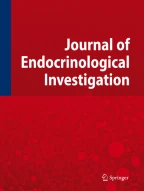Abstract
This prospective clinical trial was designed to assess the effects of a long-term therapy with spironolactone, with and without dietary-induced weight-loss, on clinical features, lipid profile and insulin levels in women with polycystic ovary syndrome (PCOS). Twenty-five patients (range of age 16–32 yr; 13 lean and 12 overweight) fulfilling formal diagnostic criteria for PCOS (oligomenorrhea and/or amenorrhea, biochemical and/or clinical evidence of hyperadrogenism) were studied at baseline and then received oral spironolactone (100 mg/die) for 12 months; association with lifestyle modifications was recommended to all overweight patients. Clinical, endocrine and metabolic parameters [oral glucose tolerance test (OGTT), lipid profile] were measured at baseline and at the end of the antiandrogen treatment. The therapy was associated with a significant average decline of triglycerides in overweight subjects and with increased HDL-cholesterol levels in lean patients. The insulin levels at 60 min during OGTT, homeostasis model assessment-insulin resistance and area under curve of insulin were significantly lowered in overweight women after 12 months of spironolactone and weight loss and no negative changes in insulin secretion and sensitivity were observed in PCOS women after pharmacological treatment alone. The efficacy of spironolactone on the androgenic clinical aspects of PCOS has been confirmed in this study. Furthermore, our data show that long-term treatment with spironolactone exerts no negative effects on lipoprotein profile and glucose metabolism; more relevant beneficial effects on glucose and lipid metabolism were observed when the antiandrogen was associated with weight loss in overweight PCOS women.
Similar content being viewed by others
References
Azziz R, Saenger P. The Second International Symposium on the Developmental Aspects of Androgen Excess, Toronto, Canada, 20 June 2000. Trends Endocrinol Metab 2000, 11: 338–40.
Legro RS. Polycystic ovary syndrome: the new millennium. Mol Cell Endocrinol 2001, 184: 87–93.
Legro RS, Kunselman AR, Dodson WC, Dunaif A. Prevalence and predictors of risk for type 2 diabetes mellitus and impaired glucose tolerance in polycystic ovary syndrome: a prospective, controlled study in 254 affected women. J Clin Endocrinol Metab 1999, 84: 165–9.
Poretsky L. On the paradox of insulin-induced hyperandrogenism in insulin-resistant states. Endocr Rev 1991, 12: 3–13.
Giudice LC. The insulin-like growth factor system in normal and abnormal human ovarian follicle development. Am J Med 1995, 98: 48S–54S.
Diamanti-Kandarakis E. How actual is the treatment with antiandrogen alone in patients with polycystic ovary syndrome? J Endocrinol Invest 1998, 21: 623–9.
Talbott EO, Zborowski JV, Sutton-Tyrrell K, McHugh-Pemu KP, Guzick DS. Cardiovascular risk in women with polycystic ovary syndrome. Obstet Gynecol Clin North Am 2001, 28: 111–3.
Dawber TR, Meadors GF, Moore FE Jr. Epidemiological approaches to heart disease: the Framingham Study. Am J Public Health 1951, 41: 279–81.
Pasquali R, Antenucci D, Casimirri F. Clinical and hormonal characteristics of obese and amenorrheic hyperandrogenic women before and after weight loss. J Clin Endocrinol Metab 1989, 68: 173–89.
Kiddy DS, Hamilton-Fairley D, Bush A, Short F, Anyaoku V, Reed MJ. Improvement in endocrine and ovarian function during dietary treatment of obese women with polycystic ovary syndrome. Clin Endocrinol (Oxf) 1992, 36: 101–11.
Krowchuk DP, Lucky AW. Managing adolescent acne. Adolesc Med 2001, 12: 355–74.
Ludwig E. Classification of the types of androgenetic alopecia (common baldness) occurring in the female sex. Br J Dermatol 1977, 97: 247–54.
Matthews DR, Hosker JP, Rudenski AS, et al. Homeostasis model assessment: insulin resistance and beta-cells function from fasting plasma glucose and insulin concentrations in men. Diabetologia 1985, 28: 412–9.
Diamanti-Kandarakis E, Tolis G, Duleba A. Androgens and therapeutic aspects of antiandrogens in women. J Soc Gynecol Invest 1995, 2: 577–92.
Cumming DC, Yang JC, Rebar RW, Yen SS. Treatment of hirsutism with spironolactone. JAMA 1982, 247: 1295–8.
Moghetti P, Tosi F, Castello R, et al. The insulin-resistance in women with hyperandrogenism is partially reversed by antiandrogen treatment; evidence that androgens impair insulin action in women. J Clin Endocrinol Metab 1996, 81: 952–60.
Gokmen O, Senoz S, Gulekli B, Isik AZ. Comparison of four different treatment regimes in hirsutism related to polycystic ovary syndrome. Gynecol Endocrinol 1996, 10: 249–55.
Wild RA, Demers LM, Applebaum-Bowden D, Lenker R. Hirsutism: metabolic effects of two commonly used oral contraceptives and spironolactone. Contraception 1991, 44: 113–24.
Vrbikova J, Cibula D, Dvorakova K et al. Insulin sensitivity in women with polycystic ovary syndrome. J Clin Endocrinol Metab 2004, 89: 2942–5.
Dunaif A, Segal KR, Futterweit W, Dobrjansky A. Profound peripheral insulin resistance, independent of obesity, in polycyst ovary syndrome. Diabetes 1989, 38: 1165–74.
Author information
Authors and Affiliations
Corresponding author
Rights and permissions
About this article
Cite this article
Zulian, E., Sartorato, P., Benedini, S. et al. Spironolactone in the treatment of polycystic ovary syndrome: Effects on clinical features, insulin sensitivity and lipid profile. J Endocrinol Invest 28, 49–53 (2005). https://doi.org/10.1007/BF03345529
Accepted:
Published:
Issue Date:
DOI: https://doi.org/10.1007/BF03345529



